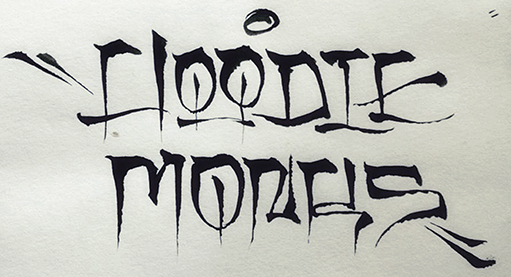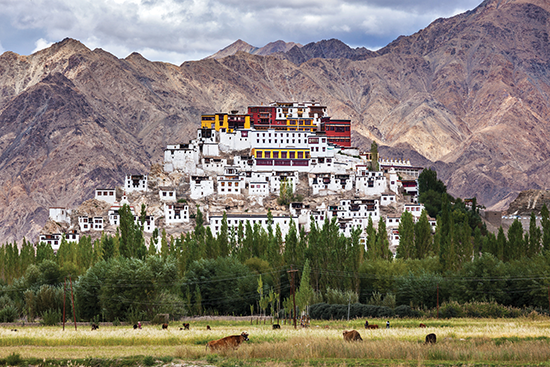
Rockin’ the Dharma
Could Buddhist rock and dharma pop be the next hot subgenres? There are promising signs in Japan.
At Yugasan Rendaiji, a Shingon Buddhist temple in Okayama, once-silent halls now resound with hip-hop, courtesy of the Hoodie Monks. Gomyo, aka Kevin Seperic, an American-born rapper ordained as an ajari, or Shingon priest, introduced rapping to attract a new generation of priests to fill the dwindling ranks. Gomyo, who fronts FBSD (Free Buddha, Spit Dharma), says the Hoodie Monks offer an alternative to mainstream hip-hop, with its “materialistic” message, and demonstrate that Buddhism is not only relevant to daily life but also cool. Even Rendaiji’s septuagenarian abbot, Zoko Saeki, has picked up the beat—or at least endorsed it—“to keep the teachings going and alive.”
Meanwhile, the Num-Num Girls, 13 teens from East Kyushu Ryukoku High School in Kyushu, have shot to fame with PG-13, Abba-esque song-and-dance routines that convey Pure Land teachings for a happy life. (The group took its name from “Namu Amida Butsu,” the Shin devotional chant.) Their CD, DVD, live shows, and TV appearances have made the Num-Nums wildly popular throughout Japan. Too popular, it seems. Recently their parents and teachers, afraid for the girls’ safety, pulled the plug on performing in public. Luckily for their fans, however, the Num-Nums weren’t grounded altogether: they can still deliver their upbeat message at school and at local Buddhist temples.

Meet Venerable Xian Er, Robo-monk
In their scramble to attract the young and hip, artificial intelligence experts at Beijing’s Longquan (Dragon Spring) Temple hit on a high-tech solution: a chubby robotic monk programmed to answer basic questions on the dharma. Xian Er, the diminutive bot, is modeled on the star of a popular animated series created by the Longquan monks. In episodes like “The Life of Master Xian Er: When a Young Monk Meets a Robber,” the series dispenses Buddhist wisdom as entertainment. The cartoon Master Xian is made of dough, a traditional Chinese art form. But robo-monk is strictly 21st- century: he holds an iPad-like tablet that displays answers to visitors’ queries spoken into a microphone
Buddha on Mars
You’ve heard the wacky tales: Jesus’s image turns up on a banana peel, the Virgin Mary’s on a piece of toast. Now it’s the Buddha’s turn to manifest somewhere unlikely—in this case, on Mars. UFO hunters scrutinizing photos from NASA’s Curiosity rover claim to see a statue of the Buddha on one of the red planet’s hills. Calling it proof “that intelligent life once existed on Mars,” Scott Waring of UFO Sightings Daily accused NASA of suppressing the finding. NASA denied a cover-up, offering a down-to-earth explanation: pareidolia, a mental twist that makes us perceive something that isn’t there. It’s akin to apophenia, the brain’s tendency to look for meaningful patterns, allowing us, for example, to spot familiar faces in a crowd. “Seeing” the Buddha on Mars, experts say, likely comes from viewing extreme blowups of the photos that show fuzzy, distorted images.
Buddha or Mars rock formation? You be the judge.

Binge-Watching with the Buddha
Hopelessly behind on episodes of Game of Thrones? Samsung Sweden knows how you feel. To launch their new SUPER HD TV set, the company sponsored a “Leave Reality Behind” contest, with a 100-day, all-expenses-paid, binge-watching retreat as the prize. The location? Thikse Gompa, a 600-year-old Tibetan Buddhist monastery in India’s remote Himalayan province of Ladakh.
A tongue-in-cheek video, one of four TV ads, shows the humongous 65-inch set being steered through crowded Indian streets, hoisted onto a truck, then carted across the vast Indus Valley on the back of an ox, before being handed off to workers for the dizzying climb to Thikse Gompa, elevation 11,800 feet. There, the set was installed in a room lined floor to ceiling with Buddhist texts.
The contest was the brainstorm of DDB Stockholm, Samsung’s Nordic ad agency. Searching for a peaceful, spiritual spot, the agency chose Thikse Gompa, a Gelugpa monastery, for its remote location and “very hospitable” head lama, Thiksey Khenpo Rinpoche. A local film company that had shot at the monastery, and Tundup Wangyal, a tour guide in Leh, smoothed the way. Though the monks aren’t allowed to watch TV—“we have all renounced worldly attachments,” Thiksey Rinpoche points out—he had no problem hosting a binge-watcher.
The winner of the “Catch-Up Grant”—which includes a stipend to cover lost income—was Ingebeth Solveig Drost, a former TV production assistant from Copenhagen, who beat out over 60 contestants to be named most TV-series deprived. Before she went on retreat in October, Drost was asked if she planned to do anything but binge-watch. “I want to do some meditation and yoga—and just being,” she said. She’ll have plenty of opportunities. Drost has the run of Thikse Gompa, a huge complex resembling the Potala Palace in Llasa, Tibet, until her retreat ends in late February.
Thank you for subscribing to Tricycle! As a nonprofit, we depend on readers like you to keep Buddhist teachings and practices widely available.
